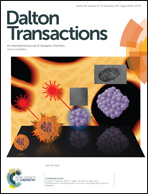Targeting divalent metal cations with Re(i) tetrazolato complexes†
Abstract
In order to exploit their potential as versatile luminescent sensors, four new Re(I)-tetrazolato complexes with the general formula fac-[Re(CO)3(diim)(L)], where diim is 2,2′-bipyridine (bipy) or 1,10-phenanthroline (phen) and L− is either the anion 5-(2′-pyridyl)tetrazolato (2-PTZ−) or 5-(2′-quinolyl)tetrazolato (2-QTZ−), were prepared and fully characterized. In all cases, the regioselective coordination of the Re(I) center through the N2 atom of the tetrazolato ring was observed. This particular feature ensures the availability of the diiminic (N^N) site that was systematically incorporated into the structure of the 2-PTZ− and 2-QTZ− ligands for further coordination with metal cations. Such a diimine-type coordination mode was preliminarily tested by using the mononuclear Re(I) complexes as N^N ligands for the preparation of two [(N^N)Cu(POP)] cationic species, where POP is the chelating diphosphine bis[2-(diphenylphosphino)phenyl]ether. The X-ray structures of the resulting Re(I)–Cu(I) dyads revealed that the Re(I) mononuclear complexes effectively behaved as chelating N^N ligands with respect to the [Cu(POP)]+ fragment, the coordination of which also resulted in significant modification of the Re(I)-centered luminescence. With these data in hand, the luminescent sensing abilities of the four new Re(I) tetrazolato complexes were screened with respect to divalent metal ions of toxicological and biological importance such as Zn(II), Cd(II) and Cu(II). The interaction of the Re(I) complexes with Zn(II) and Cd(II) was witnessed by the evident blue shift (Δλmax = 22–36 nm) of the emission maxima, which was also accompanied by a significant elongation of the emission lifetimes. On the contrary, the addition of the cupric ion caused substantial quenching of the radiative processes originating from the Re(I) luminophores.


 Please wait while we load your content...
Please wait while we load your content...